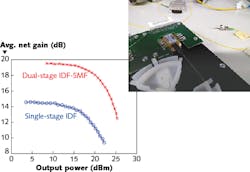Optical Fiber Amplifiers: Revisiting Raman amplifiers: improving bandwidth beyond EDFA capabilities
To extend the reach of C-band (1530–1565 nm) fiber-optic communications and boost transmission of high-bandwidth 1550 nm signals, erbium-doped fiber amplifiers (EDFAs) have historically been the amplification method of choice. Unfortunately, the gain bandwidth of these amplifiers is limited to around 40 nm, severely limiting their information-carrying capacity as carrier demand for bandwidth continues to grow at more than 20% per year. And, although dual-stage Raman amplification has been studied in the past as a potential alternative, single pump wavelengths have limited the bandwidth to around 20 nm—far from suitable as a replacement for EDFAs.
By expanding the pump options for Raman systems, however, researchers at Aston University (Birmingham, England) have developed Raman amplifiers with high gain (20 dB) and high power (>22 dBm) that have a bandwidth of >100 nm, far exceeding the capabilities of traditional EDFAs.1
Combining two fiber types
Although many Raman amplifiers can use dispersion-shifted, dispersion-compensating, and nonlinear optical fibers, double Rayleigh scattering and induced multipath interference limits signal-to-noise ratio (SNR) and gain of the amplifier to an upper limit of 15 dB.
These Raman amplifiers are so named because they use the stimulated Raman-scattering effect in passive optical fibers to provide optical-gain-downshifted output (around 13 THz) from the pump laser wavelengths. In these experiments, a set of pump wavelengths between 1425 and 1490 nm were available, but the optical gain can be tailored to any wavelength band by choosing appropriate laser pumps. This contrasts with EDFAs that are pumped at 980/1480 nm and whose gain bandwidth is determined by the erbium-doped fiber.
To reduce these nonlinear penalties, the researchers combined 10 km of inverse-dispersion fiber (IDF) to achieve 14.5 dB of gain, and then added a second stage with 10 km of standard single-mode fiber (SMF) to add 5 dB of gain and increase the saturation output power by an additional 3 dB, bringing the total gain to 22.5 dBm (see figure).
The two-stage amplifier design maximizes the gain of the first stage IDF (with lower input power and lower nonlinear crosstalk) and minimizes nonlinear crosstalk while maximizing saturated output power in the second stage SMF that has relatively high optical power.
In an actual transmission experiment that used wavelength-selective switches (WSSs) to create a total of 24 channels with 300 GHz spacing, introduction of a single-stage amplifier and a dual-stage IDF and SMF amplifier showed superior gain for the latter amplifier architecture.
“Utilization of the single-mode fiber bandwidth beyond the C-band is a practical approach to increasing fiber capacity while making use of existing fiber cables in the ground,” says Wladek Forysiak, principal investigator of the Engineering and Physical Sciences Research Council (EPSRC; www.epsrc.ac.uk) project researching Raman amplifiers at Aston University. “Discrete Raman amplifiers are one possible way forward in this regard, and although their potential has been recognized for many years, their time may well have come now. The dual-stage architecture proposed in our paper not only reduces nonlinear penalties in transmission, but with some modifications it has the potential to increase gain bandwidth well beyond 100 nm in a single unsegmented device.”
REFERENCE
1. L. Krzczanowicz et al., Opt. Express, 26, 6, 7091–7097 (2018).
About the Author

Gail Overton
Senior Editor (2004-2020)
Gail has more than 30 years of engineering, marketing, product management, and editorial experience in the photonics and optical communications industry. Before joining the staff at Laser Focus World in 2004, she held many product management and product marketing roles in the fiber-optics industry, most notably at Hughes (El Segundo, CA), GTE Labs (Waltham, MA), Corning (Corning, NY), Photon Kinetics (Beaverton, OR), and Newport Corporation (Irvine, CA). During her marketing career, Gail published articles in WDM Solutions and Sensors magazine and traveled internationally to conduct product and sales training. Gail received her BS degree in physics, with an emphasis in optics, from San Diego State University in San Diego, CA in May 1986.
